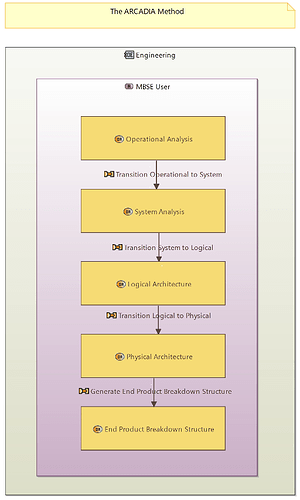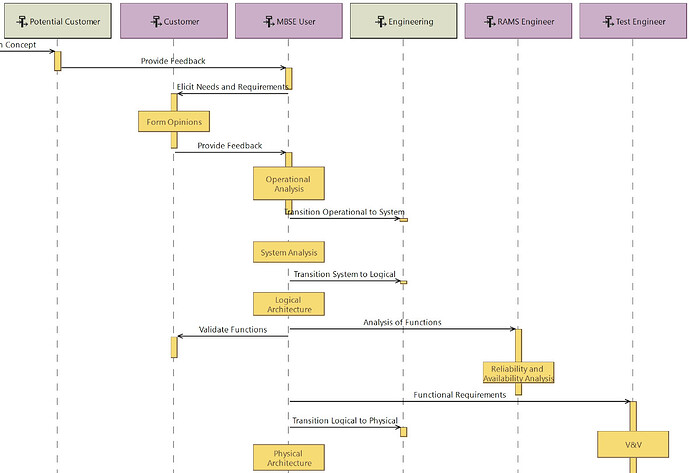Hi, I would like to introduce the company to Architecture Frameworks, ARCADIA, and Eclipse Capella, via a guided tour of a model.
My idea was to start from Operational Analysis, to show how it can support the business, through concurrent engineering, management of interfaces and organizing sub-contracts through EPBS etc., and better connect from user-needs to engineering. Showing Actors as named points of contact for practically who to contact for things like modeling and architecture, with their job roles.
Then perhaps going into System Analysis, breaking down ARCADIA steps or putting them in the context of business processes (or ISO 15288:2015 processes).
Has anyone already used ARCADIA to deploy ARCADIA? Are there any example models like this?
1 Like
Hello,
I am not sure I was able to pin down what exactly you need, but here are a few resources for you to look at:
1 Like
Thanks for the links. I got a lot of value from the Innovating with Capella playlists when I was getting started.Though I’m not after any training materials for myself.
Instead, I am after a model, built in Capella, which represents the Organization as the system, deploying Eclipse Capella to support product development. This would then itself be part of the training material for people getting started. It would demonstrate the ARCADIA method, within the Capella tool; A meta-model for ARCADIA. The Operational Capabilities might include “Achieve Business Goals”, “Manage Interfaces”, “Concurrent Engineering”. I’m just surprised that one hasn’t been done yet, and so I’m building one myself.
I discovered the INCOSE Systems Engineering Process Model, which models the standard ISO/IEC/IEEE 15288:2015 System and software lifecycle processes. It’s built on the open-source tool “Archi”, which much like Enterprise Architect uses ArchiMate. This is pretty close to what I was looking for. Though not exactly ARCADIA.
1 Like
Hi @Epictetus and @cherry_picker,
This is an interesting topic.
I have described and shared a MBSE with Arcadia step-by-step in this webpage: iexcelarc.com
It describes in a high-level, what it can be done and diagrams to be produced as outcome of each of the steps.
1 Like
Hi Helder, thanks for sharing. I did find your articles on LinkedIn quite useful also.
Though I’m not after any training materials for myself.
Instead, I am after a model, built in Capella, which represents the Organization as the system, deploying Eclipse Capella to support product development. This would then itself be part of the training material for people getting started. It would demonstrate the ARCADIA method, within the Capella tool; A meta-model for ARCADIA. The Operational Capabilities might include “Achieve Business Goals”, “Manage Interfaces”, “Concurrent Engineering”.
There was a recent release of Arcadia Reference Documents (eclipse.org) which does include an Arcadia-compliant Capella model of Arcadia - That’s the closest thing to what I am after, though here it is "Arcadia-as-a-System’ and not the ‘Organization-as-a-System’ within the scope of an Arcadia/Capella deployment.
1 Like
There are a couple of organizations I know that did what you are looking for. Nothing public yet as far as I am aware, but there is a good chance some of them may present their work in the future. Not sure when though.
Stephane
1 Like
Thanks @Epictetus for your comment.
We do have a similar task to capture the organization process. The work has been postponed several times.
I thought it could start from the Operational Analysis capturing the different stakeholders who do have an interest in Arcadia for an organization and it could end at Physical Architecture with tools to achieve their goals. However, it depends on what objectives you are aiming for your reference architecture.
I am happy to share some thoughts with you, if you wish.
@StephaneLacrampe a presentation or public releases will be great to learn from. Do let me know if you aware of any of them in future.
@HelderCastro Thanks for the response. The purpose might be “to achive successful implementation of Eclipse Capella within the organization”. What better way for one to manage the Capella implementation than to use Capella itself.
Early on it would provide the means to communicate the business case and to convince the stakeholders to get onboard with the effort, and pass the data (requirements, users, deployment structure) over to the IT department to implement. It would also define the interfaces to the customer, between Engineering and IT, or Engineering and Testing, and between the organization and the market, and capture the stakeholder needs and requirements for system architecting and product development. Then it would dive through the specific implementation; the specific names or roles of each actor in an OEBD, which actor does what, and where it’s deployed, which other systems it exchanges data with, and how it’s used in each department, with scenarios such as the version control process, or a requirements process.
By the way since I first posted this, I have made such a model. I cannot post in full as it contains company data and names of employees. It does the job but isn’t super great. Though wonder if anyone else had done something similar.
Hi there,
That sounds like an exciting topic for a Capella Day.
If anyone has substantial content he’d like to present to the community, the call for submissions is still open for a few hours. 

Samuel
1 Like
@Epictetus that is an interesting view and approach.
Reading all your posts above I believe at certain point the question: “Why MBSE in an organisation?” is answered, captured all the stakeholders and needs, that is:
- External stakeholders: client/users, standards and regulators. Regulators and standards may impose constraints on the MBSE deployment, for example the design shall be made available in a document form.
- Internal stakeholders: product owners, requirements engineers, IVV teams, RAMS, cost, etc. Need to get access to the model. It may arise the need to make it available for non-Capella users. Word? HTML?
I believe you may have all the support needed from a project/organization. From the diagrams, you are trying to capture what are the user needs and what is needed to deploy and support the MBSE effort from your organisation, correct?
I would start gathering operational capabilities from the customer, for example:
- Provide requirements capture and traceability. Requirements can be captured in an external tool and means to trace them may be required. E.g. Requirements Management tool + additional tool to connect and trace to model elements?
- Design a system/service. Capella tool?
- Make model available. E.g. users may be granted with access to the server - IT support? Export model to word - additional Capella add-ons? Python4Capella scripts development?
- Simulate model. Use of external tools to connect and simulate?
From above: Operational Entities and actors, Operational Capabilities (OC) will be captured. It is then possible to identify and capture activities and scenarios that will validate each OC.
Another point you may wish to consider and from my point-of-view, I would keep the business case and process analysis to a single layer: Operational Analysis. Why? It may be easier to show to and navigate to non-Arcadia/Capella users and less work to define and validate.
Unless, you would like to reuse the process for future projects. A topic that you may have the answer already.
I hope the above is aligned with your thoughts and it does help.
1 Like

